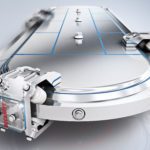Rather than traditional standalone systems, modern motion systems are integrated into the overall machine environment, making for easier connectivity and IoT implementations. Here, Daymon Thompson, U.S. Software Product Manager and Sree Swarna Gutta, U.S. I/O Product Manager, Beckhoff Automation LLC, weigh in on how their technologies are enabling this transition.
1. What edge devices do you supply or support to allow for use of feedback signals or distributed motion control?

Daymon Thompson: Any Beckhoff machine controller with motion control capability can be very easily and quickly configured to process feedback signals, status and many other pieces of information locally. They can also send this valuable data to another edge device or directly to the cloud. Any of these devices also support distributed motion control, even across multiple controllers using real-time protocols such as EtherCAT, EtherCAT Automation Protocol (EAP) or other real-time publisher-subscriber (pub/sub) mechanisms.
2. Have you begun to sell (or seen use of) gateways to give new and legacy equipment more connectivity?
Sree Swarna Gutta: Beckhoff supports more than 30 different fieldbus systems. This helps customers connect with legacy devices, especially in brownfield sites. A single Beckhoff controller can even act as sort of a “Swiss Army Knife” of protocols. The controller could serve as a gateway to legacy protocols, such as DeviceNet, PROFIBUS, Modbus, Serial, CANopen, etc., to modern IoT protocols, including MQTT, AMQP and HTTPS/REST, and industrial Ethernet protocols like EtherCAT, PROFINET, EtherNet/IP and so on.
Also, I/O devices like IoT bus couplers give customers the flexibility to add new technology to existing machines without having to do a complete redesign. For example, engineers could add the EK9160 IoT Bus Coupler from Beckhoff directly to the I/O segment and establish communication via a simple configuration page rather than programming. Combined with new sensors to collect power, vibration or other data, this retrofitting for IoT strategy could add completely new optimization and predictive maintenance capabilities to existing machines without having to change the existing controls.

3. Do you offer any new I/O options?
Beckhoff offers a full line of high-end measurement modules that are well suited to motion applications. Traditionally, high-end measurement modules were limited to test and lab environments, partially because of their high price points. In particular, the new ELM series delivers high-resolution and high-accuracy data measurement on an industrial machine through affordable, compact, EtherCAT-integrated modules. With machine builders moving more toward predictive maintenance, the need for data collection is more important than ever. Any data analysis is only as good as the quality of data you can collect. With the Beckhoff high-end measurement modules, machine builders and end users can collect a wide range of data at up to 50 ksps at 24-bit resolution and 100 ppm accuracy.
4. How are the IIoT and increasingly networked manufacturing prompting changes in the way motion systems are installed?
Daymon Thompson: Using PC-based control, modern motion systems are no longer seen as standalone platforms. Today, wide-ranging motor and drive technologies are fully integrated with the overall machine control environment. This integrated approach enables simple configuration for enhanced vertical connectivity and IIoT implementations. As such, engineers have to consider not only the capabilities of the individual components but also the automation software that enables a fully integrated engineering and runtime. Users should seek out software platforms that can handle as much of the programming as possible under one roof – including, PLC, motion control, safety, HMI, measurement and monitoring, machine vision and, of course, IoT.
Beckhoff Automation LLC
beckhoff.com/ethercat
beckhoff.com/industrie40







Leave a Reply
You must be logged in to post a comment.